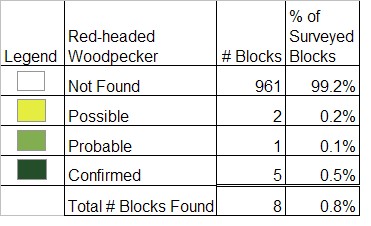Breeding Bird Atlases (BBA)
Find a Bird - BBA1
Breeding Bird Atlas 1 Species Accounts
Red-headed Woodpecker
Melanerpes erythrocephalus
Egg Dates
May to June 17
Number of Broods
one; may re-lay if first attempt fails.

The status of this striking woodpecker varies from a local permanent resident to a very uncommon visitor. Believed formerly to have been more common, the Red-headed Woodpecker apparently declined in the Northeast around the turn of the century. A description of its distribution today in Massachusetts matches that given by Forbush. At best, it is a rare and irregular breeder and an occasional migrant and wintering bird. The species may turn up in any section of the state, but there are generally more records from the western portions.
Open farm country with scattered oak or beech groves is the preferred habitat. The spread of Dutch Elm Disease and subsequent die-off of large elms provided ideal nest locations. However, by the mid-1970s many of these dead giants had fallen to chainsaws or storms and high winds. In other portions of the range, and to a lesser extent in Massachusetts, competition with starlings for nest sites has limited or reduced the populations. In the Commonwealth, Red-headed Woodpeckers will return to the same breeding site for several years in succession, with adults sometimes wintering in the area. Then, for reasons unknown, they will abandon the location.
Spring migrants arrive here in late April and early May, and nesting commences in late May or early June. Nest sites are usually in dead trees adjacent to large fields or farmland, but telephone poles and old fence posts are sometimes used. A post-Atlas nest in Westboro was in a dead tree 20 feet out in the water of an open swampy impoundment (McMenemy). The nesting cavity is 8 to 24 inches deep and may be located from 5 to 80 feet above the ground. Clutches of four to seven pure white eggs are incubated by both sexes for 12 to 14 days. Limited data on nestlings and fledglings indicate that nests with eggs can be found from May to the end of June. If the first attempt fails, the birds appear to be single-brooded in our area. The young fledge at 27 to 30 days of age. At the Westboro nest, a single nestling was still being fed on July 26 and had fledged by August 12 (McMenemy). During the Atlas period, pairs, each with three fledged young, were observed in Lynn and Pittsfield in early July.
The young remain together throughout the summer before migrating. In their brown-and-white juvenal plumage, they appear quite different from their parents. The bright adult plumage, identical for both sexes, is acquired through a gradual fall-winter molt and is renewed each year after the breeding season.
These birds are quite noisy, regularly producing a variety of loud, scold notes. One common call is similar to that of the Great Crested Flycatcher: a loud churr-churr. Other listeners liken some raspy notes to those of the Gray Treefrog. Another sound has been described as quee-o, quee-o. In spite of being so vocal and showy, these woodpeckers can be surprisingly inconspicuous when nesting.
Like several related species, the Red-headed Woodpecker often will store nuts and acorns, hiding them in holes and crevices. During summer, much of their diet consists of insects, especially grasshoppers and beetles. Consequently, they can be seen swooping from a perch low over fields, much in the manner of flycatchers and waxwings, in quest of their insect prey. Wintering birds usually are found in oak groves or near livestock feedlots or well-stocked bird feeders, where they will take corn, suet, and sunflower seeds.
Fall migration occurs in late September and October, and, because flights often take place during the day, hawk watchers should always be on the lookout for this uncommon beauty. Most Red-headed Woodpeckers winter in the southern United States, but some adults that have nested in Massachusetts may remain, or sometimes a migrant will settle into a favorable area for the winter.
Map Legend and Data Summary
Atlas 1 data collected from 1975-1979


Note: rare, local, and irregular; chiefly in interior river valleys, occasionally elsewhere
Thomas H. Gagnon



